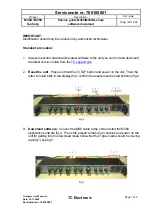MSC8144E Reference Manual, Rev. 3
4-4
Freescale
Semiconductor
Chip-Level Arbitration and Switching System (CLASS)
4.2
Functional Description
The CLASS is a non blocking interconnect between up to 16 initiators and up to 16 targets. The
main sub-blocks of the CLASS are: expander, multiplexer and arbiter, normalizer, and the
CLASS control interface (CCI) unit that implements the interface and interrupt lines and the
CLASS register files. The CLASS also implements an inherent debug and profiling unit (CDPU).
To implement the protocol that deals with the point-to-point bus, the CLASS includes an
expander module per initiator that performs address decoding and is used as sampling stage on
the initiator side. Each expander module can detect an error address and generate an interrupt. For
more details about the expander module see Section 4.2.1. From the target side, the CLASS
includes a multiplexer and arbiter module and a normalizer module for each target. The
multiplexer and arbiter module performs a pseudo round-robin (RR) arbitration algorithm
between all the initiators and concentrates them toward one target. For details about multiplexer
and arbiter module see Section 4.2.2. Each multiplexer and arbiter module has a dedicated
normalizer module that is used as the sampling stage on the target side. The normalizer can also
be used for normalizing transactions. For more details about normalizer module see Section
4.2.3.
The MSC8144E device CLASS modules support different bus widths, numbers of initiator
devices, and number of target devices. Table 4-1 lists the characteristics of the three CLASS
modules.
4.2.1
Expander Module and Transaction Flow
Each expander module connects to one initiator. The expander module performs address
decoding according to the configuration register settings. Each target is presented by a start
address and an end address that define a window in the memory space. The address decoding is
done by checking whether the transaction address hits one of the active windows. Each expander
module is connected to all of the multiplexer and arbiter blocks in the CLASS to implement a
full-fabric and non-blocking interconnect between any initiator to any target. If the address
decoding hits in more than one window, the CLASS arbiter chooses a window by fixed priority
arbitration (target 0 has the lowest priority). After detecting the requested target and the arbiter
selects the target window, the expander module starts a transaction toward the associated
Table 4-1. CLASS Module Parameters
Module
Internal Bus
Width
Initiators Supported
Targets Supported
CLASS0
128-bit
6
DSP core subsystems 0–3, DMA
Controller, and CLASS1
5
M2 Ports 0–3 and CLASS1
CLASS1
128-bit
5
L2 ICache, QUICC Engine
subsystem, DMA Controller,
CLASS0, and CLASS2
5
DDR Controller, M3, PCI
Controller, Configuration and
Control Registers, and CLASS0
CLASS2
64-bit
3
Serial RapidIO Controller, TDM,
PCI Controller
1
CLASS1
Summary of Contents for MSC8144E
Page 1: ...MSC8144E Reference Manual Quad Core Media Signal Processor MSC8144ERM Rev 3 July 2009 ...
Page 48: ...MSC8144E Reference Manual Rev 3 xlviii Freescale Semiconductor ...
Page 86: ...MSC8144E Reference Manual Rev 3 1 38 Freescale Semiconductor Overview ...
Page 168: ...MSC8144E Reference Manual Rev 3 3 60 Freescale Semiconductor External Signals ...
Page 242: ...MSC8144E Reference Manual Rev 3 5 26 Freescale Semiconductor Reset ...
Page 314: ...MSC8144E Reference Manual Rev 3 8 24 Freescale Semiconductor General Configuration Registers ...
Page 414: ...MSC8144E Reference Manual Rev 3 10 14 Freescale Semiconductor MSC8144E SC3400 DSP Subsystem ...
Page 452: ...MSC8144E Reference Manual Rev 3 11 38 Freescale Semiconductor Internal Memory Subsystem ...
Page 520: ...MSC8144E Reference Manual Rev 3 12 68 Freescale Semiconductor DDR SDRAM Memory Controller ...
Page 1070: ...MSC8144E Reference Manual Rev 3 21 28 Freescale Semiconductor Timers ...


















